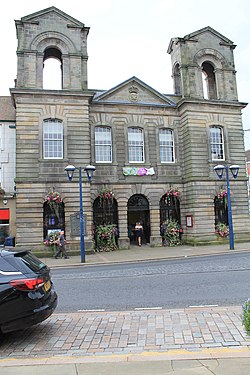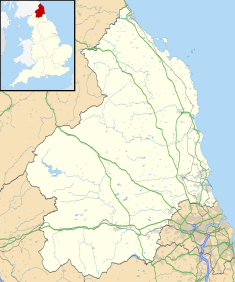|
Morpeth Town Hall
Morpeth Town Hall is a municipal building in the Market Place, Morpeth, Northumberland, England. The structure, which was the meeting place of Morpeth Borough Council, is a Grade II listed building.[1] HistoryThe building was commissioned in the early 18th century by the lord of the manor, the 3rd Earl of Carlisle.[2] It was designed by John Vanbrugh in the Baroque style, built in rusticated ashlar stone and was completed in 1714.[1][3] The design involved a symmetrical main frontage with five bays facing onto the Market Place with the end bays projected forward as towers with voussoirs and open pediments in the top stage.[1] The central section of three bays featured three arched openings containing wrought iron grills on the ground floor; there were segmental headed sash windows on the first floor and an entablature, a cornice and a pediment above with a coat of arms in the tympanum.[1] Internally, the principal rooms were the butter market and, behind it, the corn exchange on the ground floor,[4] and the assembly hall on the first floor.[1] In September 1758, an army sergeant was killed and two other soldiers badly injured when 3,000 ammunition cartridges exploded in an accident in the town hall.[5] In the early 19th century theatrical events took place in the town hall with Macbeth being performed there.[6] After significant population growth, largely associated with Morpeth's status as a market town, the area became a municipal borough, with the town hall as its headquarters, in 1835.[7] The town hall was badly damaged in a fire in 1869 and the façade was subsequently restored, so as to create an exact reproduction of the original, and the structure behind it completely rebuilt; this was all at the expense of the 8th Earl of Carlisle, under the supervision of the local architect, Robert James Johnson.[8] In February 1909, the suffragette and British Liberal Party politician, Alison Garland addressed a meeting in the town hall during which she spoke about votes for women as well as broader political issues.[9] In 1917, the industrialist Lord Joicey bought the town hall from the 11th Earl of Carlisle and presented it to the town, refusing to accept re-imbursement despite a fund raising campaign organised by civic officials.[10] The building then remained the headquarters of the borough council until it moved to new offices at No. 36 Bridge Street which were opened by the mayor, Richard Elliott, on 5 May 1939.[11][12] The town hall remained the main venue for civic events in the town and later accommodated the offices of Morpeth Town Council as well as the local registrar's office: it also became an approved venue for weddings and civil partnership ceremonies.[13] An extensive programme of restoration works costing £1.1 million was commissioned by the Greater Morpeth Development Trust, carried out to a design by Napper Architects and was completed in 2009.[14] The works involved improved access to the butter market and the restoration of the grand staircase.[15] A bust, designed by Helen Ridehalgh, depicting the former Commander-in-Chief of the Mediterranean Fleet, Vice-Admiral Lord Collingwood, was installed in the butter market in March 2013.[16] Works of art in the town hall include a portrait by Thomas Lawrence of the former Lord Privy Seal, the 6th Earl of Carlisle,[17] as well as portraits by Thomas Bowman Garvie of Alderman George Barron Grey[18] and of Alderman George Young.[19] Other items of interest displayed in the mayor's parlour include a strong box known as the "town hutch" commissioned by Lord Dacre and containing documents dating back to 1513, a ceremonial mace made in 1604 and several cannonballs used in the siege of Morpeth in January 1644 during the English Civil War.[20][21] References
Further reading
Information related to Morpeth Town Hall |
||||||||||||||||||||||||||

